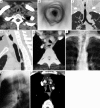Imaging of the trachea
- PMID: 29707497
- PMCID: PMC5900079
- DOI: 10.21037/acs.2018.03.09
Imaging of the trachea
Abstract
Numerous benign and malignant tracheal diseases may affect the trachea primarily and secondarily. While the posterior anterior (PA) and lateral chest radiograph is the conventional study for initial evaluation of the trachea and central airways, findings may not always be apparent on conventional radiographs, and further evaluation with cross sectional imaging is usually necessary. Computed tomography (CT) is the imaging modality of choice for imaging the trachea and bronchi. Familiarity with the imaging appearances of the normal and diseased trachea will enhance diagnostic evaluation.
Keywords: Trachea; tracheal stenosis; tracheal tumor; tracheomalacia.
Conflict of interest statement
Conflicts of Interest: The authors have no conflicts of interest to declare.
Figures









References
Publication types
LinkOut - more resources
Full Text Sources
Other Literature Sources
